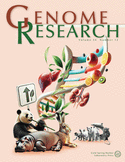Intronic Sequences Flanking Alternatively Spliced Exons Are Conserved Between Human and Mouse
Abstract
Comparison of the sequences of mouse and human genomes revealed a surprising number of nonexonic, nonexpressed conserved sequences, for which no function could be assigned. To study the possible correlation between these conserved intronic sequences and alternative splicing regulation, we developed a method to identify exons that are alternatively spliced in both human and mouse. We compiled two exon sets: one of alternatively spliced conserved exons and another of constitutively spliced conserved exons. We found that 77% of the conserved alternatively spliced exons were flanked on both sides by long conserved intronic sequences. In comparison, only 17% of the conserved constitutively spliced exons were flanked by suchconserved intronic sequences. The average length of the conserved intronic sequences was 103 bases in the upstream intron and 94 bases in the downstream intron. The average identity levels in the immediately flanking intronic sequences were 88% and 80% for the upstream and downstream introns, respectively, higher than the conservation levels of 77% that were measured in promoter regions. Our results suggest that the function of many of the intronic sequence blocks that are conserved between human and mouse is the regulation of alternative splicing.
Footnotes
-
[Supplemental material is available online at www.genome.org.]
-
Article and publication are at http://www.genome.org/cgi/doi/10.1101/gr.1208803.
-
↵3 Corresponding author. E-MAIL gilast{at}post.tau.ac.il; FAX 972-3-640-9900.
-
- Accepted March 26, 2003.
- Received January 22, 2003.
- Cold Spring Harbor Laboratory Press











